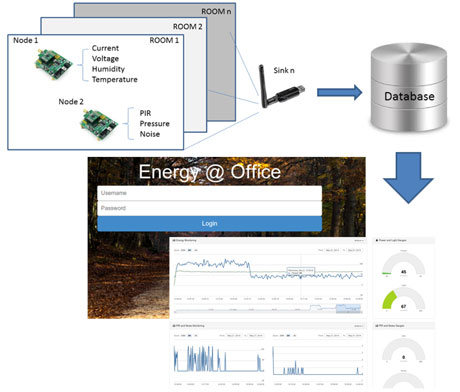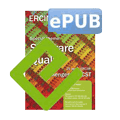by Paolo Barsocchi, Antonino Crivello, Erina Ferro, Luigi Fortunati, Fabio Mavilia and Giancarlo Riolo
“Renewable Energy and ICT for Sustainability Energy” (or “Energy Sustainability”) is a project led by the Department of Engineering, ICT, and Technologies for Energy and Transportations (DIITET) of the Italian National Research Council (CNR). This project aims to study and test a coordinated set of innovative solutions to make cities sustainable, with respect to their energy consumption.
To achieve its goal, the project is based on i) the widespread use of renewable energy sources (and related storage technologies and energy management), ii) the extensive use of ICT technologies for the advanced management of energy flows, iii) the adaption of energy-efficient city services to demands (thus encouraging rationale usage of energy resources and, thus, savings), and iv) the availability of energy from renewable sources.
This project is aligned with the activities of the European Commission under their energy efficiency theme. By June 2014, the European Member States will have to implement the new Directive 2012/27/EU (4 December 2012). This Directive establishes that one of the measures to be adopted is “major energy savings for consumers”, where easy and free-of-charge access to data on real-time and past energy consumption, through more accurate individual metering, will empower consumers to better manage their energy consumption [1].
The Energy Sustainability project focuses on six activities. We are involved in the “in-building” energy sustainability component. The main goal of this sub-project is to compute the real energy consumption of a building, and to facilitate energy savings when and where possible, through the experimental use of the CNR research area in Pisa. This research area is more complex than a typical, simple building, as it hosts 13 institutes. However, energy to the area is supplied through a single energy source, which means that the institutes have no way of assessing their individual energy consumption levels.
The main requirements of the In-Building sub-project are that it must:
- monitor the power consumption of each office (lights and electrical sockets),
- regulate the gathering and visualization of data via permits,
- support real-time monitoring and the ability to visualize time series,
- define energy saving policies,
- be cheap and efficient.
We developed an Energy long-term Monitoring System (hereafter referred to as the EMS@CNR), which is composed of a distributed ZigBee Wireless Sensor Network (WSN), a middleware communication platform [2] and a set of decision policies distributed on the cloud (Figure 1). At the time of writing, there are sensor nodes of this WSN installed in some offices of our Institute (CNR-ISTI). Each sensor node can aggregate multiple transducers such as humidity, temperature, current, voltage, Passive Infrared (PIR), pressure sensors and noise detector. Each node is connected to a ZigBee Sink, which provides Internet-of-Things connectivity through the IPv6 addressing methodology. The choice to use a ZigBee network was driven by several technology characteristics, such as ultra low-power consumption, the use of unlicensed radio bands, cheap and easy installation, flexible and extendable networks, integrated intelligence for network set-up and message routing.

Figure 1: The EMS@CNR system and the WebOffice platform." title="Figure 1: The EMS@CNR system and the WebOffice platform.
In order to measure the energy consumption of a room, we need to assess the values of current and voltage waveforms at the same instant. This is driven by the need to operate within existing buildings, without the possibility of changing existing electrical appliances. We used a current and voltage transformer. We also installed a PIR and a noise detector in a single node, and a set of pressure detectors, installed in another node under the floating floor, in order to determine the walking direction of a person (i.e., to detect if he is entering or leaving the office). This helps to determine whether or not someone is in the office, which is an information that drives decisions regarding potential energy savings for that specific room. As an example, in an office where nobody is present, lights and other electric appliances (apart from computers) can be automatically switched off. Currently, the decision policies do not take into account data coming from welfare transducers, such as temperature and relative humidity. This data will be included in the in-progress decision policies.
Sensor data collected by the deployed WSN are stored in a NoSQL document-oriented local database, such as MongoDb. In order to provide both a real-time view of the sensor data and a configuration interface, we implemented a web interface, named WebOffice, that runs on JBoss 7.1. It implements the JavaEE specification and it is free and open-source. The Web interface provides a login system to protect data display and ensure privacy. After making a successful login, according with the permission, the sensor data are shown in the main page. There are two main types of graphics: dynamic charts (for real-time visualization and historical data) and gauges (for an immediate display of the last value recorded).
Links:
ZigBee: http://www.zigbee.org/
JBoss: http://www.jboss.org/overview/
References:
[1] L. Pérez-Lombard, J. Ortiz, C. Pout: “A review on buildings energy consumption information,” Energy and buildings, vol. 40, no. 3, pp. 394–398, 2008
[2] F. Palumbo et al.: “AAL Middleware Infrastructure for Green Bed Activity Monitoring”, Journal of Sensors, vol. 2013, pp. 1-15.
Please contact:
Erina Ferro, ISTI-CNR, Italy
E-mail:











